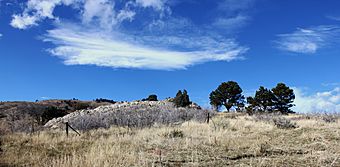Magic Mountain site facts for kids
The Magic Mountain site is an ancient village located in Jefferson County, Colorado. People lived here a very long time ago, from about 4999 BC to 1000 AD. This means the site shows evidence of life from both the Archaic and Woodland periods.
The site was officially added to the National Register of Historic Places in 1980. It got its name from the Magic Mountain Amusement Park, which owned the land in the late 1950s. A hundred years before that, the area was known as the Apex mining district and had a small stop for stagecoaches.
Contents
Where is the Magic Mountain Site?
The Magic Mountain site is found in the foothills of the Rocky Mountains, near Apex Creek. This area is special because it's where the mountains meet the plains. It's a place where different kinds of plants and animals can be found.
Ancient History of the Area
Scientists divide the ancient history of this part of Colorado into different time periods. These include the Paleo-Indian, Archaic, and Woodland periods. Each period shows how people lived and adapted to their environment over thousands of years.
The Archaic Period: Hunters and Gatherers
People living during the Archaic period were skilled hunters and gatherers. They hunted smaller animals like deer, antelope, and rabbits. They also collected wild plants for food. These groups moved around with the seasons, following game and finding the best places to gather plants.
Later in the Archaic period, around 200-500 AD, something new happened:
- People started growing corn as part of their diet.
- They also began making pottery. This was a big step because pottery helped them store and carry food more easily.
The Woodland Period: Settling Down
During the Woodland period, people started to live in one or two places for longer periods. They became more diverse in their ways of life.
- They began to farm and grow crops.
- They also started to domesticate animals, meaning they raised animals for their own use.
- Making pottery and baskets became common.
- They also performed special ceremonies.
Uncovering the Past: Archaeology
Archaeology is the study of human history through digging up artifacts and other remains. At the Magic Mountain site, archaeologists have learned a lot about the people who lived there long ago.
Tools and Artifacts Found
Archaeologists found many stone tools and projectile points (like arrowheads or spear points) at the site. These finds helped experts understand more about the Archaic and Woodland cultures in the area. Some unique projectile points found here were even named "Apex points" after the site. They were similar to points found in New Mexico.
The archaeological evidence was found in six different layers of soil, which scientists called Zones A through F. Each layer represents a different time period:
| Time Period | Approximate Dates | Culture |
|---|---|---|
| Early Archaic | 4050-3050 BC | Zone F. Mount Albion culture. |
| Early Archaic | 3050-2050 BC | Zone E. Magic Mountain culture. |
| Middle Archaic | 1550 - 810 BC | Zone D. Apex culture. |
| Late Archaic | 810 BC - AD 100 | Zone C. Front Range culture. |
| Colorado Plains Woodland | AD 100 - 1000 | Zone B. South Platte culture. |
| Colorado Plains Woodland | AD 100 - 1000 | Zone A. South Platte culture. |
Some artifacts from the Fremont culture were also found in Zone A. Scientists believe these items were obtained through trading with other groups. A small ancient cemetery was discovered at the site, which first led to the archaeological discoveries. Sadly, some parts of the site had been disturbed before official excavations began.
Who Excavated Magic Mountain?
Many different groups of archaeologists have worked at the Magic Mountain site over the years to uncover its secrets.
| Date | Who Studied It? | What They Found |
|---|---|---|
| 1956 | Regional studies | Initial research in the area. |
| 1959–1960 | Cynthia Irwin-Williams, Peabody Museum of Harvard University | Discovered three ancient burials. Her findings were published in a book in 1966. |
| 1994 & 1996 | Centennial Archaeology LLC | Continued archaeological work. |
| 2017-2018 | Paleocultural Research Group and Denver Museum of Nature and Science | Latest studies and excavations. |
Where are the Artifacts Now?
In 2001, a collection of 2,500 artifacts from the Magic Mountain site was moved to the Denver Museum of Nature and Science. This means you can visit the museum to see some of the tools and items used by people thousands of years ago!
Why is This Site Important?
The Magic Mountain site is very important for understanding ancient history. It has a large collection of artifacts from the Early, Middle, and Late Archaic periods. It also includes burial sites and shows a history of different cultures living in the same area over time.


